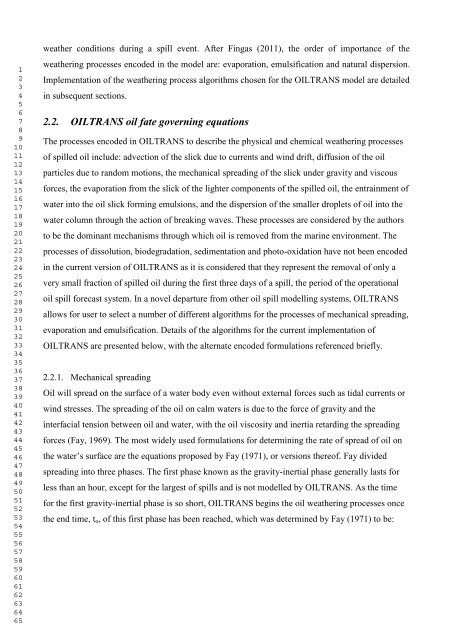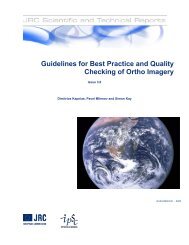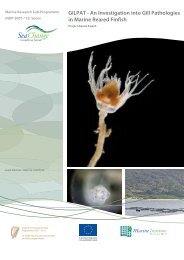The oil spill model OILTRANS and its application to the Celtic Sea ...
The oil spill model OILTRANS and its application to the Celtic Sea ...
The oil spill model OILTRANS and its application to the Celtic Sea ...
You also want an ePaper? Increase the reach of your titles
YUMPU automatically turns print PDFs into web optimized ePapers that Google loves.
1234567891011121314151617181920212223242526272829303132333435363738394041424344454647484950515253545556575859606162636465wea<strong>the</strong>r conditions during a <strong>spill</strong> event. After Fingas (2011), <strong>the</strong> order of importance of <strong>the</strong>wea<strong>the</strong>ring processes encoded in <strong>the</strong> <strong>model</strong> are: evaporation, emulsification <strong>and</strong> natural dispersion.Implementation of <strong>the</strong> wea<strong>the</strong>ring process algorithms chosen for <strong>the</strong> <strong>OILTRANS</strong> <strong>model</strong> are detailedin subsequent sections.2.2. <strong>OILTRANS</strong> <strong>oil</strong> fate governing equations<strong>The</strong> processes encoded in <strong>OILTRANS</strong> <strong>to</strong> describe <strong>the</strong> physical <strong>and</strong> chemical wea<strong>the</strong>ring processesof <strong>spill</strong>ed <strong>oil</strong> include: advection of <strong>the</strong> slick due <strong>to</strong> currents <strong>and</strong> wind drift, diffusion of <strong>the</strong> <strong>oil</strong>particles due <strong>to</strong> r<strong>and</strong>om motions, <strong>the</strong> mechanical spreading of <strong>the</strong> slick under gravity <strong>and</strong> viscousforces, <strong>the</strong> evaporation from <strong>the</strong> slick of <strong>the</strong> lighter components of <strong>the</strong> <strong>spill</strong>ed <strong>oil</strong>, <strong>the</strong> entrainment ofwater in<strong>to</strong> <strong>the</strong> <strong>oil</strong> slick forming emulsions, <strong>and</strong> <strong>the</strong> dispersion of <strong>the</strong> smaller droplets of <strong>oil</strong> in<strong>to</strong> <strong>the</strong>water column through <strong>the</strong> action of breaking waves. <strong>The</strong>se processes are considered by <strong>the</strong> authors<strong>to</strong> be <strong>the</strong> dominant mechanisms through which <strong>oil</strong> is removed from <strong>the</strong> marine environment. <strong>The</strong>processes of dissolution, biodegradation, sedimentation <strong>and</strong> pho<strong>to</strong>-oxidation have not been encodedin <strong>the</strong> current version of <strong>OILTRANS</strong> as it is considered that <strong>the</strong>y represent <strong>the</strong> removal of only avery small fraction of <strong>spill</strong>ed <strong>oil</strong> during <strong>the</strong> first three days of a <strong>spill</strong>, <strong>the</strong> period of <strong>the</strong> operational<strong>oil</strong> <strong>spill</strong> forecast system. In a novel departure from o<strong>the</strong>r <strong>oil</strong> <strong>spill</strong> <strong>model</strong>ling systems, <strong>OILTRANS</strong>allows for user <strong>to</strong> select a number of different algorithms for <strong>the</strong> processes of mechanical spreading,evaporation <strong>and</strong> emulsification. Details of <strong>the</strong> algorithms for <strong>the</strong> current implementation of<strong>OILTRANS</strong> are presented below, with <strong>the</strong> alternate encoded formulations referenced briefly.2.2.1. Mechanical spreadingOil will spread on <strong>the</strong> surface of a water body even without external forces such as tidal currents orwind stresses. <strong>The</strong> spreading of <strong>the</strong> <strong>oil</strong> on calm waters is due <strong>to</strong> <strong>the</strong> force of gravity <strong>and</strong> <strong>the</strong>interfacial tension between <strong>oil</strong> <strong>and</strong> water, with <strong>the</strong> <strong>oil</strong> viscosity <strong>and</strong> inertia retarding <strong>the</strong> spreadingforces (Fay, 1969). <strong>The</strong> most widely used formulations for determining <strong>the</strong> rate of spread of <strong>oil</strong> on<strong>the</strong> water‟s surface are <strong>the</strong> equations proposed by Fay (1971), or versions <strong>the</strong>reof. Fay dividedspreading in<strong>to</strong> three phases. <strong>The</strong> first phase known as <strong>the</strong> gravity-inertial phase generally lasts forless than an hour, except for <strong>the</strong> largest of <strong>spill</strong>s <strong>and</strong> is not <strong>model</strong>led by <strong>OILTRANS</strong>. As <strong>the</strong> timefor <strong>the</strong> first gravity-inertial phase is so short, <strong>OILTRANS</strong> begins <strong>the</strong> <strong>oil</strong> wea<strong>the</strong>ring processes once<strong>the</strong> end time, t o , of this first phase has been reached, which was determined by Fay (1971) <strong>to</strong> be:
















